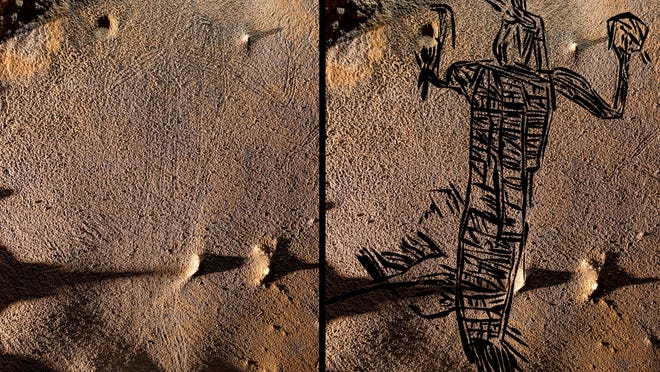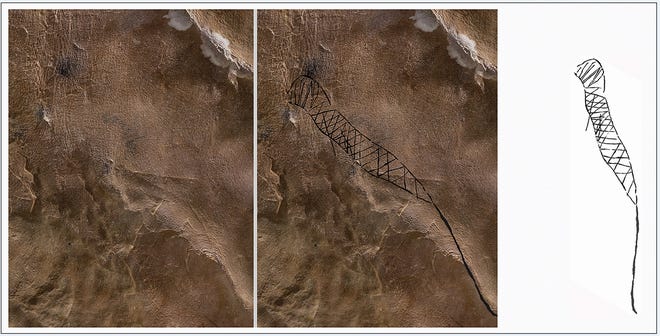
- Archaeologists have discovered the most significant grouping of cave art drawings built by Native Us citizens prior to the arrival of Spanish explorers.
- Researchers took thousands of superior-tech pictures to scan the ceiling of the cave in Alabama to generate a 3D product.
- Inspection of the digital cave ceiling revealed 1000’s of drawings, such as quite a few daily life-sized pictures.
Researchers applied 3D scanning technological know-how to reveal what they say is the largest selection of cave artwork drawings at any time uncovered in North America.
Between the glyphs learned on the ceiling of a cave in Alabama is a serpent-formed figure that steps about 11 ft, scientists described in research released Wednesday in the peer-reviewed journal Antiquity.
The five illustrations of Native American cave artwork documented in the study were the premier uncovered and estimated to be 1,000 to 1,800 a long time old, mentioned co-writer Jan Simek, an archaeologist and professor of anthropology at the College of Tennessee. But the system employed to create a photorealistic, virtual 3D model of the cave in fact revealed “countless numbers of supplemental glyphs and visuals,” in accordance to a tale documenting the investigation in the Historic Art Archive.
“It was stunning to see them, but it was not surprising they had been there,” Simek advised United states of america Now.
Which is since archaeologists have discovered numerous illustrations of open up-air rock artwork made ahead of Spanish explorers arrived in North The usa. But much of that has been observed by archaeologists discovering burial websites.

Arizona arrest:40-calendar year-old father arrested immediately after using section in struggle at son’s higher university
‘I study banned books’:Tennessee library releases a library card to beat guide bans
These new revelations appear right after Simek – a board member of the non-profit archive – and study co-author Alan Cressler very first posted results in 1999 about the cave, recognized as “19th Unnamed Cave” to secure its area from looters. After Cressler subsequently seen some additional faint mud drawings in the cave’s ceiling, they made the decision to examine more.
To precisely seize the ceiling’s topography, the study’s third co-creator Stephen Alvarez, who is also a founder of the Historical Artwork Archive, proposed the 3D mapping venture. He put in numerous months having more than 16,000 higher-resolution photographs in the extra than 5,000-square-foot chamber.
Those overlapping pictures were being stitched together into a 3D design using photogrammetry, a application technologies also used in creating digital maps and environments, and digital objects for video games these types of as Get in touch with of Obligation.
Alvarez also built a custom made personal computer to tackle the processing right after a single computer’s motherboard melted whilst compiling the pictures.

Inside of the potent 3D software, the researchers could shine digital gentle on the ceiling’s surface to reveal earlier unseen drawings. Many etchings ended up faint or obscured as humidity and rain experienced worn them absent, the scientists claimed.
The 3D design also furnished a superior vantage level for evaluating the cave surface due to the fact “the tight actual physical confines of the cave” necessary you to crouch or be inclined to check out it in individual, they reported. As a result, you are normally way too close to the ceiling to discern images. “We can actually fall the flooring absent from the ceiling in the model,” Simek advised United states of america Now.
What’s all people talking about? Sign up for our trending e-newsletter to get the most current information of the day
The initial cave artists created these lifestyle-sized and much larger drawings “without the need of getting equipped t
o see them in their entirety,” the scientists wrote in Antiquity. “Consequently, the makers worked from their imaginations, relatively than from an unimpeded visible point of view.”
What ended up they actually drawing? Considering the fact that caves had been sacred spots to Indigenous People in america of the Southeast U.S. – and considered “pathways to the underworld,” the scientists write – the stylized human forms, depicted below with rattlesnakes, may depict spiritual spirits.
“We would characterize them as human-like forms, but it is challenging to notify whether they are individuals in elaborate regalia or perhaps supernatural figures,” Simek stated. “That means is tough this considerably into the earlier.”
Historic art in caves was unanticipated by many archaeologists, he claimed. “We have been enthusiastic to see these matters emerge by the method of this analytical approach,” Simek mentioned.
The researchers have demonstrated the findings to the Japanese Band of Cherokees’ once-a-year archaeology conference. “They were being really fascinated by what we have been seeing,” Simek claimed.
The Cherokee Country, along with the Muscogee Creek Country, the Chickasaw Country, and the Choctaw Country, are amid the tribes whose descendants lived in the location at the time the drawings had been built.
Photogrammetry has subsequently been used in a number of other caves in the Southeast. “What amazes me about making use of 3D modeling is that a tale that was laid down a thousand plus years back and has been invisible can now be seen in its entirety,” Alvarez said.
“The artists who engraved the cave are talking to us,” he claimed. “We can use 3D modeling to listen.”

Abide by Mike Snider on Twitter: @mikesnider.
